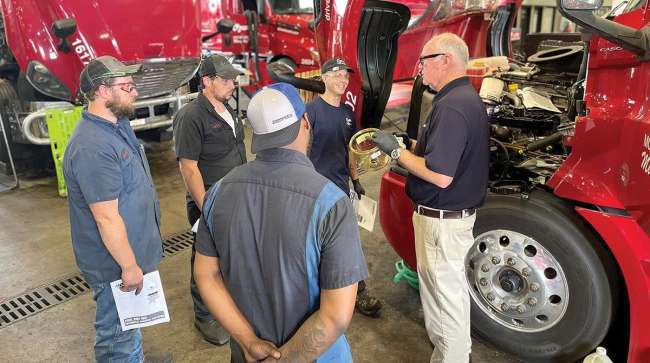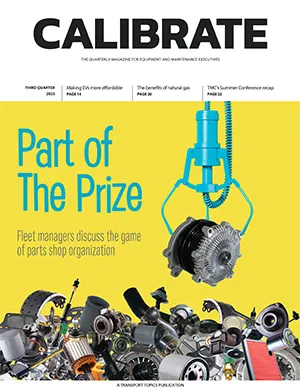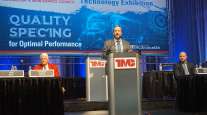Contributing Writer
Fleets Tackle Parts Shop Organization

[Find the latest in equipment & maintenance: Explore this quarter's issue of Calibrate]
Ozark Motor Lines completes a monthly parts inventory, but it does it one week at a time. Breaking up the process into four 25% chunks creates consistency and routine for the 750-power-unit fleet, said Vice President of Fleet Maintenance Wayne Skinner.
Skinner, who also is leading a TMC task force on parts room strategy, said a full monthly check can be so daunting that it doesn’t get done.
“So if we do it weekly, it’s a more manageable approach to making sure you complete that inventory every month,” he said.
The Memphis, Tenn.-based company instituted the weekly checks as part of a new systematic parts strategy launched at the end of 2022 for its five shop locations. After each weekly inventory is completed, the parts team updates variances and investigates trends. The process ensures all parts are charged on repair orders.

More Q3 Calibrate
►Fleets Tackle Parts Shop Organization
►Freeze: Step Up Push to Bring Veterans Into Trucking
►Trucking Industry Works to Make Electric CVs More Affordable
►Baxter: Natural Gas Engines Could Reduce Fuel, Maintenance
►TMC Corner: Summer Conference Places Priority on Education
Explore the Issue!
Every six months, aging inventory is scrutinized. If a part is commonly found and has no supply chain challenges, the company will return it to its supplier and request a credit it typically receives. Employees have found parts for equipment that is no longer in the fleet.
This strategy helps parts clerks maintain an organized shop. Some tools are stored and managed by the clerks, with technicians required to check them out to prevent them from being lost. Bays have stenciled areas where technicians place parts after completed repairs so clerks can put them in the right place and track them.
To procure parts, Ozark Motor Lines relies primarily upon its dealership groups and nationwide parts suppliers. The company tries to use only original equipment manufacturer parts for its all-Freightliner fleet. Non-OEM parts are tested, and Skinner has to approve them. The company starts with a 90-day test that is expanded if successful. Once there is a consensus that a part is a good fit, it will be assigned a part number.
The Right Part at the Right Time
Having the right parts available when they are needed is the key to success, said Chris Carter, vice president of maintenance for XPO. It eliminates downtime and equipment being brought into the shop more than once.
XPO, which operates more than 35,000 tractors and trailers serviced by 61 shops, annually bids out its parts business to suppliers who can service the company’s nationwide footprint. Cost is not the only factor; the company is looking for suppliers who can meet the company’s needs, such as delivering parts frequently. Likewise, when it comes to the parts themselves, the company looks at the total cost of ownership, such as wear rates and replacement mileages.
XPO uses a maintenance management system to streamline procurement. Usage histories are reviewed to determine the best inventory levels for each part. If an on-hand part drops below a minimum threshold, the system automatically reorders. Parts clerks order noninventory parts at the request of technicians. If a part has been special-ordered more than twice in a 90-day period, it probably will be added to inventory. The company evaluates its inventory settings quarterly. The settings change based on seasons, the age of equipment and other factors.

To eliminate downtime, XPO uses a maintenance management system to streamline procurement. (XPO)
“As a data-driven organization, we’re constantly looking at data to identify trends,” Carter noted. “We look for parts that are being used consistently and should be added to our inventory while simultaneously finding existing items in our inventory that are no longer in use and discontinuing them in a way that still captures some of their value.”
XPO, based in Greenwich, Conn., ranks No. 5 on the Transport Topics Top 100 list of the largest for-hire carriers in North America.
Chris Hough, vice president of maintenance design and engineering for Penske Truck Leasing, is part of a company with 426,000-plus trucks, more than 10,900 technicians and more than 930 shops across North America.
Penske orders stock parts daily at a system level through a centralized parts ordering team. The team recommends stocking levels and reorder points and also recommends the preferred supplier for each part. Locations’ fleet profiles are considered. The team also considers fleet activity along with units coming out of service and new ones coming in.
Penske, based in Reading, Pa., ranks No. 15 on the for-hire TT100 list.

Fleet managers agree that a clean and organized shop helps with productivity. (Associated Asphalt)
Associated Asphalt supplies liquid asphalt in nearly 35 facilities on the East Coast. The company has 53 trucks and about 250 trailers in six of those, and about 130 tank containers that ship to the Caribbean. It has two shops — one in Columbia, S.C., and one in Tampa, Fla., with two mechanics in each shop and a fabricator in the Tampa shop. The shops do basic preventive maintenance and minor repairs such as brake jobs.
Ernest Hamilton, senior transportation manager, emphasized the importance of avoiding storing unnecessary parts. The company tries to identify parts that are no longer needed — if a part isn’t moving, it tries to get rid of it. It discovered one shop had Peterbilt parts even though the fleet hadn’t used the brand for years.
Hamilton said he doesn’t like to keep parts that have been removed from a truck, even if they might still be usable.
“If you took it off, it’s not any good as far as I’m concerned,” he said. “Let’s get rid of it and move on because otherwise you’re just going to have a bunch of clutter.”
Keeping the Bay Organized
In addition to parts distribution and procurement, proper fleet shop design and organization produce more efficient operations. Hamilton said technicians have carts stocked with all the tools needed for preventive maintenance as they make their way around a truck. Ozark Motor Lines recently updated all of its lighting in Memphis with higher lumen LED lights and is doing the same at its other shop locations.

Ozark Motor Lines monitors its monthly parts inventory on a weekly basis. (Ozark Motor Lines)
Ozark Motor Lines tries to follow the 5S model of “sort, set, shine, standardize and sustain.” The company recently completed an oil and fluid container location project. Barrels that were scattered around the preventive maintenance areas have been moved to the shop walls’ inner perimeter and sit atop stenciled areas on the floor. Shop equipment such as jacks also is stored on stenciled areas. Technicians know the tools need to go there at their shifts’ end.
“The whole idea is to have a repeatable and consistent, safe work environment,” Skinner said. “One thing that you kind of boil it down to: Everything has a place, and a place has a thing.”
Carter said XPO prioritizes shop space, safety and cleanliness. By strategically placing high-volume parts closest to the working area and planning the location of shop tools and equipment, the company can minimize steps technicians take to complete a job.
The company emphasizes keeping work areas clean and uncluttered. Time is allotted at the end of shifts for cleaning floors and larger items. Work benches and trash receptacles are placed to facilitate the cleaning process. Air, electrical and fluid drops also are strategically placed with cords kept off the shop floor. Each year, the company has a weeklong spring cleaning. Shop managers and supervisors walk through shops at each shift’s beginning and end. Corporate leaders visit shop facilities several times a year to reinforce the message.
“It’s all about finding that right balance where functionality, safety and cleanliness come together to create an efficient and well-organized shop environment that supports our employees to do their best work,” Carter said.
Want more news? Listen to today's daily briefing above or go here for more info
Penske field associates, corporate maintenance teams and the service bay efficiency/technology team work with the facilities group on the design of new facilities to improve efficiency and address technology changes, Hough noted. When side and front tractor fairings became more standard in Penske’s fleet, the company added wheel lifts in all of its shops to make it easier for technicians.
Penske doesn’t have a set cleaning schedule but has high daily standards that include cleaning each bay when a power unit leaves the shop.
“All of our management staff is responsible for the safety and cleanliness of our locations,” he said. “Our company culture inherently drives us. If something is out of place or does not meet the company standard, our management staff is expected to act and address the issue on the spot.”
Hamilton said keeping the shop clean is a priority, which isn’t easy for an asphalt carrier that does welding work on containers. Hot substances often drip on the floor. On a schedule of once every two weeks, a scrubber cleans the floor.
“What I found is most guys want to work in a nice facility,” he said, “and they take a lot of pride in that.”




